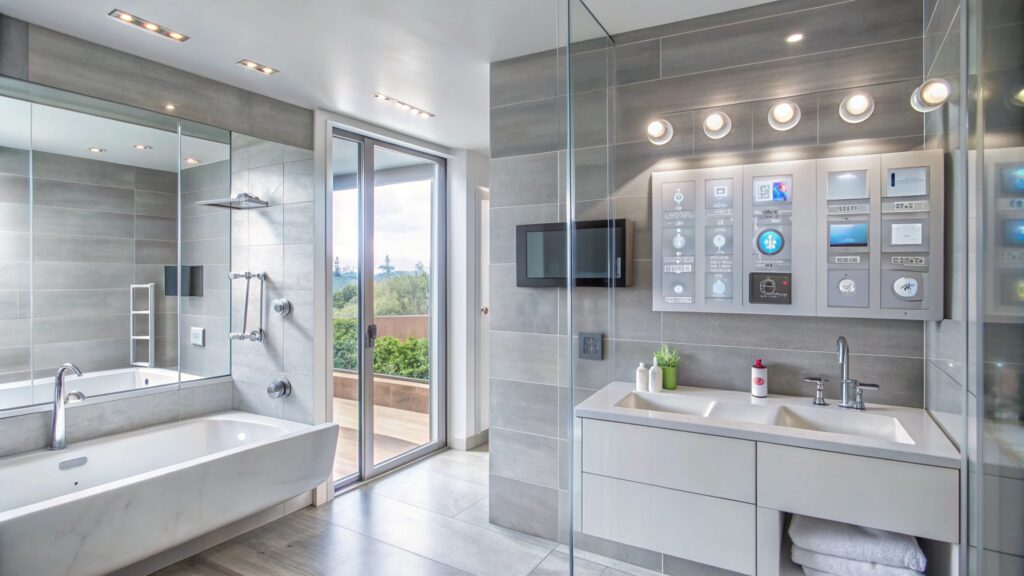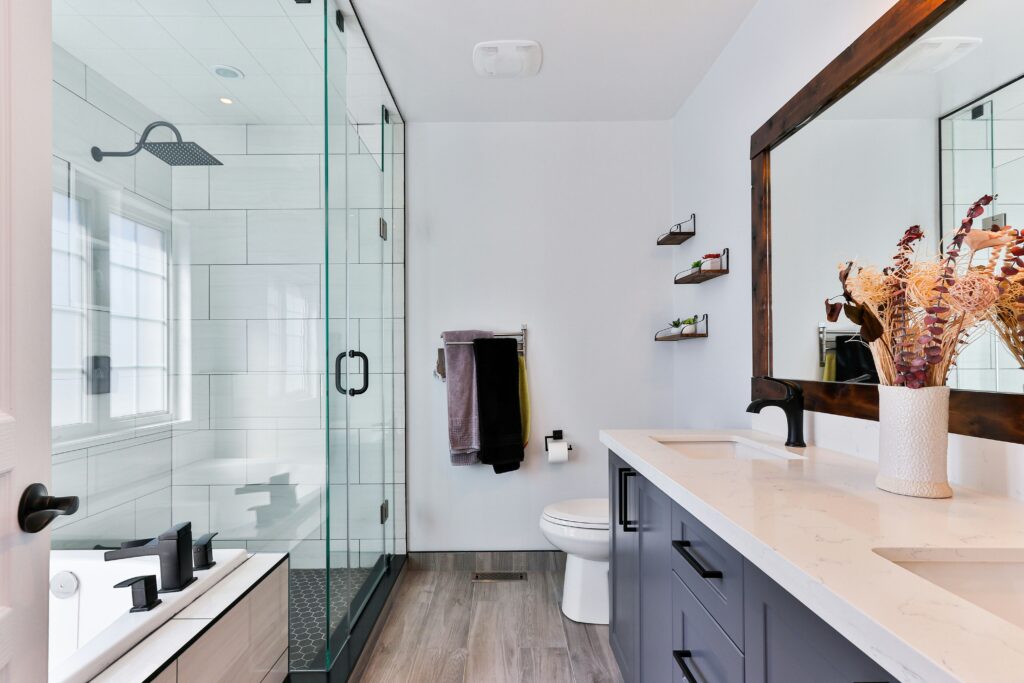A bathroom is more than just a utility space; it’s a personal sanctuary. It’s one of the most frequently used rooms in your home, and an outdated one can drastically lower your home’s appeal. That’s why planning a bathroom remodel is a significant, high-impact project. It’s a fantastic investment that improves your daily comfort and delivers one of the highest returns on investment (ROI) when you sell. This ultimate 2026 guide will provide you with the exact blueprint you need to navigate the process, from setting a realistic budget to selecting the latest, high-quality finishes. Get ready to turn your bathroom into the beautiful, functional space you deserve.
Phase 1: Foundations and Financial Planning
1. How to Establish Your Financial Limits
Deciding on a budget is the critical first step. For a typical bathroom remodel, expect project costs to range widely. A good rule is to determine a firm maximum spending limit, as this will guide every material choice you make later. Researching the average remodeling cost in your region is a smart idea.
2. Breaking Down the Project Expenses
A solid plan allocates money roughly: 40% for the skilled labor, 35% for fixtures and materials (such as the vanity, tile, and tub), and 25% for electrical, plumbing, and design fees.
3. The Non-Negotiable Emergency Fund
Never start a Bathroom remodel without an emergency fund. Always earmark 10–15% of your total budget for unexpected costs. This covers unwelcome discoveries like water damage, mold, or necessary pipe replacements found after demolition.
4. Defining Your Room’s Purpose
Before you buy a single item for Bathroom remodel, clarify the room’s main purpose. Is it a guest bath needing quick cleanup? A kids’ bath needing extreme durability? Or a master bath demanding luxury and a soaking tub?
5. Choosing a Style That Lasts
While it’s fun to look at bathroom design trends, choose a style that will look great for the next decade. Timeless design choices—like classic white or neutral tones—will always ensure a higher ROI.
Phase 2: Design and Maximizing the Layout

6. The Golden Rule of Fixture Placement
To save significantly on plumbing costs, try to keep your major fixtures (toilet, shower, vanity) in their existing locations. Moving the toilet drain or shower drain is one of the biggest budget busters.
7. Selecting the Right Bathing Solution
The biggest decision is usually the bathing area. Decide whether you need a spacious walk-in shower during the ( Bathroom remodel ) with frameless glass (highly desirable for resale) or if a practical tub/shower combo is sufficient for your family’s needs.
8. Finding the Perfect Vanity and Sink
The vanity is the room’s main piece of furniture. Prioritize storage space using deep drawers and choose a model that is scaled correctly for the size of your room. Oversized vanities can make a room feel cramped.
9. Smart Upgrades for the Toilet
Consider a comfort-height toilet for better ergonomics. For modern features, look into models with dual-flush technology for excellent water efficiency.
10. Making the Best Tile Selections
Porcelain or ceramic tile is the gold standard for bathroom flooring and shower walls due to its low porosity. When choosing a tile, select a grout color that closely matches the tile to minimize the appearance of dirt over time.
Phase 3: Materials, Lighting, and Comfort
11. Choosing Durable Countertop Surfaces
Quartz is highly recommended for bathroom countertops as it resists stains, is non-porous, and requires virtually no maintenance. This is superior to high-maintenance natural stones like marble.
12. Mastering Your Lighting Plan
Use layered lighting for functionality and atmosphere. You need bright task lighting at the vanity (flanking the mirror is best) and softer ambient lighting in the ceiling. Don’t forget a dedicated light inside the shower.
13. The Essential Role of Ventilation
A powerful exhaust fan is your first defense against mold prevention during the Bathroom remodel. Look for humidity-sensing fans that automatically turn on when the air is too moist. This protects your drywall and paint.
14. Harmonizing Fixtures and Finishes
Keep all your hardware finishes—faucets, towel bars, and cabinet pulls—in the same metal (e.g., brushed nickel throughout). Consistency creates a polished and professional final appearance.
15. Smart Ways to Increase Storage
Maximize every vertical inch. During Bathroom remodel install built-in recessed niches in the shower, use mirrored medicine cabinets that are recessed into the wall, and consider a tall linen tower for towel storage.
Phase 4: Project Management and Execution
16. Why Professional Waterproofing Matters
This is a critical area where many DIY projects fail. Insist on high-quality waterproofing membrane application behind all tile in the shower and tub area to prevent future leaks and structural damage.
17. The Importance of Hiring Specialists
While you might do the painting, always hire a licensed contractor and certified professionals for complex plumbing and electrical work. Their expertise ensures the project is safe and meets local regulations.
18. Planning for the Time Commitment
Be realistic about the project duration. A typical bathroom remodel requires detailed work and usually takes 3 to 5 weeks for construction, following several weeks of material sourcing.
19. Coordinating Inspections and Permits
A reliable contractor will manage all necessary building permits and inspections. These official checks ensure the work is up to code. You should not release the final payment until the municipality has signed off.
20. The Final Walkthrough Checklist
Before you hand over the final check for Bathroom remodel, conduct a thorough final walkthrough using a punch list. Test every faucet, flush the toilet, look for imperfect grout lines, and confirm the contractor performs a complete cleanup.
FAQs
What is the average ROI for a full bathroom remodel?
A mid-range bathroom remodel typically offers a return on investment (ROI) of 60% to 70% at resale. Focus on high-quality fixtures and clean design for the best returns.
How long should I expect to be without a functioning bathroom?
You can expect the core utilities to be disabled for the 3 to 5 weeks of construction. Your contractor should be able to provide clear milestones for toilet and shower access.
Which materials are best for a low-maintenance bathroom?
Choose large-format porcelain tiles (less grout to clean) and quartz countertops. These materials are durable, non-porous, and require minimal upkeep.
What is the first step I should take when starting a bathroom remodel?
The first step is to establish a firm budget and clearly define the scope of work. Knowing your spending limit prevents costly changes later in the project.
Should I install a separate shower and tub, or a combined unit?
Install a separate tub and walk-in shower if space allows, as this is preferred by modern buyers. If space is tight, a combined unit is the most efficient choice.




Pingback: Flooring Remodel: 7 Critical Steps to Your flooring remodel